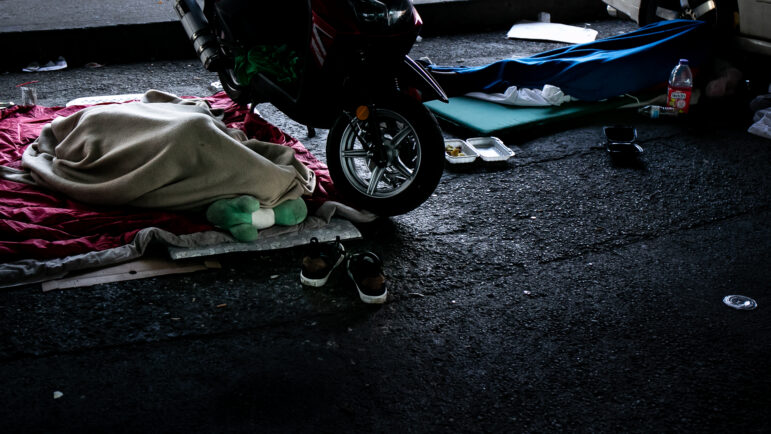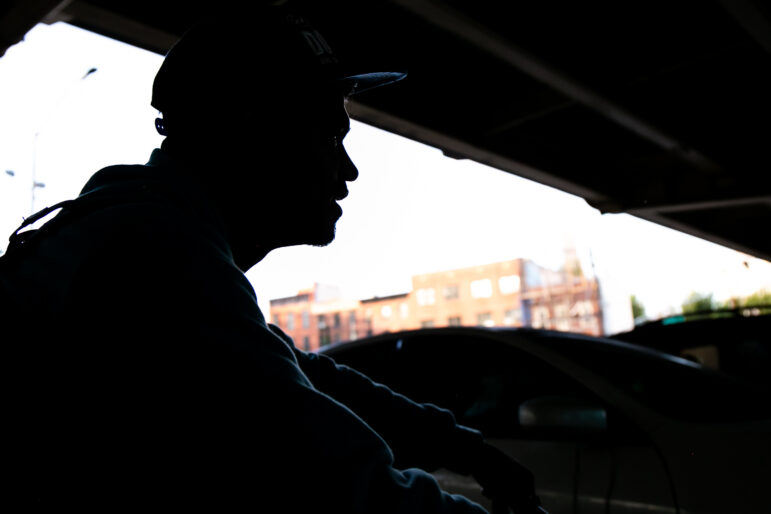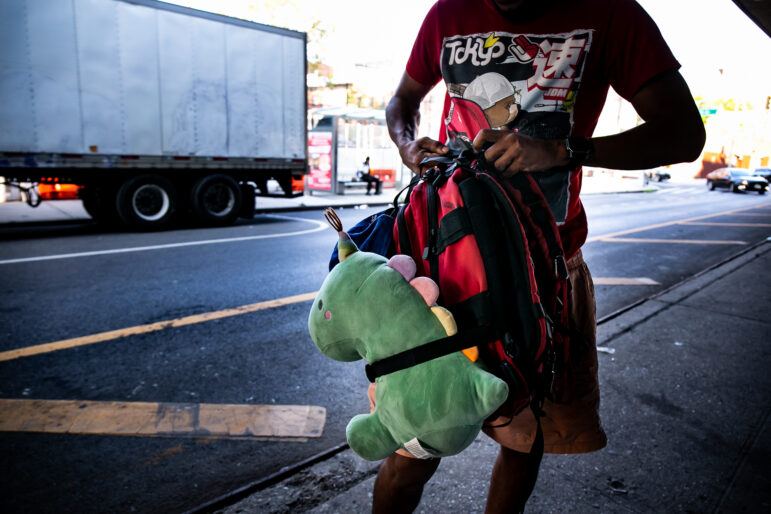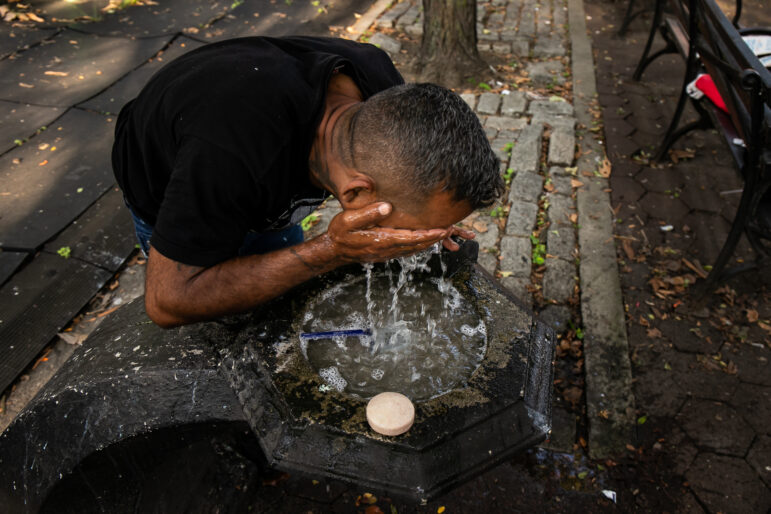The administration said this week that its shelter system is at capacity. In addition to those sleeping under the Brooklyn-Queens Expressway, dozens are also camping out on sidewalks outside the Manhattan hotel serving as the main intake center for migrants, as the city prioritizes shelter beds for families with children.

Adi Talwar
Several men sleeping on the street under the Brooklyn Queens Expressway in Clinton Hill on Tuesday morning.Lea la versión en español aquí.
Four asylum seekers awoke Tuesday to another night on the streets next to parked cars under the Brooklyn-Queens Expressway. Only the flattened cardboard boxes separating them from the concrete and a blanket or sleeping bag kept them warm from the early morning chill.
After their Brooklyn tent encampment was dismantled by the Department of Sanitation and the NYPD on July 21, where those sleeping saw their belongings thrown out, New York City Mayor Eric Adams himself met with the group of immigrants.
According to a recording of the July 23 meeting obtained by City Limits, Mayor Adams said through an interpreter—who translated simultaneously—that the group had two options: they could return to the shelter system, he said, or “I’m going to find an open space somewhere, where you can put up a tent.”
“But you can’t do it on the street. I’ll find a park area, a large area, where you can put your tent up,” the mayor said to the immigrants gathered around him.
But a week and a half later, several men are still sleeping under the expressway, saying an alternative “open” location was not offered. A City Hall spokesperson declined to comment directly on the mayor’s statements to the group.
The administration said this week that its shelter system is at capacity, as dozens are also camping out on sidewalks outside the Manhattan hotel serving as the city’s main intake center for migrants. Last month, the mayor instituted a 60-day limit for adult asylum seekers in shelter, saying the city needs to prioritize beds for families with children.
“We are seeing 2,300 people a week still coming into New York City shelter—that is unsustainable,” Deputy Mayor for Health and Human Services Anne Williams-Isom said during a press briefing Wednesday. “What we’re seeing is the ongoing struggle of a system that is buckling.”
When asked, Williams-Isom didn’t rule out the possibility of setting up sites for asylum seekers in green spaces like Central Park and Prospect Park, saying the city has reviewed more than 3,000 locations across the boroughs to potentially place people. “Right now, everything is on the table, really,” she said.
Some of the immigrants staying under the BQE had been expelled from a respite center down the block near the Brooklyn Navy Yard—one of the largest shelters the city has opened for immigrant men, with an estimated capacity of around 2,000 people—after a fight broke out there.
“It is our understanding, from our conversations with the administration, that these people were regranted access to the respite center,” Councilwoman Crystal Hudson, who represents the Clinton Hill area, told City Limits in a statement. A mayoral spokesperson also said the group was notified that that they could be reinstated to the shelter, but that not everyone took the city up on that offer.

Adi Talwar
Darwin, who asked that his full name not be used, slept on the street this week so he could keep an eye on his bike, worried about security in the the city’s shelter.
One of the men, who preferred not to be named, reported a different experience. He said that after the mayor failed to relocate them somewhere else outside as promised, he spent several nights on the street before he began asking to be let back into the respite site.
“I begged them for several days to let me come back, until a few days ago they let me in,” the young Venezuelan man said in Spanish, saying he was disappointed by what happened with the mayor. He’s now staying at the Navy Yard respite center.
Another man, Jose—who asked that his full name not be used for fear of retaliation—said he has not yet been reinstated. Jose said he has instead been sleeping on the street for more than 20 days, storing his cardboard boxes under a cart along with blankets and sleeping bags that have been donated to him by mutual aid groups.
In his backpack he keeps everything important: his documents, money, some clothes, a speaker, deodorant, nail clipper, soap to wash his face in the park, razor, and hair gel. He takes his belongings with him everywhere, as he searches for a gig that will bring him a meal or a little money.
Another man, Darwin, who asked that his full name not be used for fear of jeopardizing his immigration case, said he had forgotten his bicycle lock at work. So he preferred to sleep near the bike in the street, he said, than leave it unlocked outside the shelter—despite the security personnel posted there—after seeing the lack of security inside the respite center itself, where visitors say personal belongings cannot be left unattended, especially cell phones.
Others, like Andrew, who also asked that his full name not be used, preferred to sleep on the street with friends in Brooklyn than outside the saturated Arrival Center at the Roosevelt Hotel in midtown, where crowds have gathered on the sidewalk this week in the hopes of securing a bed.
“I went for several days,” Andrew said, sipping a juice bottle he kept under the car he slept next to. “One of those days I waited for four hours because the computer wasn’t working, they told me, but once I said I wanted to go somewhere else, they gave me the ticket [to North Carolina]. They are fast to get you out of here.”
Andrew said that a year ago, when he arrived in the Big Apple after being bused from the border in Texas, he considered the city a sanctuary for immigrants. But lately the message has been the opposite: fliers City Hall said it would be distributing to those at the border urged people crossing to consider states and cities other than New York. “Now not even the government wants you here,” Andrew said.

Adi Talwar
An asylum seeker sleeping on the street in Brooklyn gathers his belongings.
Since May, Mayor Adams announced that the city will bus asylum seekers to other localities outside the five boroughs, while still paying for the basic costs to shelter them. As of July 30, more than 56,600 migrants were under the city’s care, city Deputy Mayor Williams-Isom reported on Wednesday.
“It’s not going to get any better,” Adams warned earlier this week, adding that “from this moment on it’s downhill.”
Still, he insisted the city would not see the kind of wide-scale homeless encampments in other urban areas. “I can assure you that this city is not going to look like other cities where there are tents up and down every street,” Adams added.
But advocates for homeless New Yorkers are less confident about that prediction. Over the last few months, citing the strain on capacity, the Adams administration has sought to weaken the city’s long-standing right to shelter rules, which guarantee a shelter bed to anyone who seeks one and has no other option.
“Denying new arrivals placement and forcing people to languish on local streets is cruel and runs afoul of a range of court orders and local laws,” The Legal Aid Society and the Coalition for the Homeless, two groups leading the legal fight against the city’s right-to-shelter challenge, said in a statement Monday.

Adi Talwar
Jose, 41, freshens up at a water fountain in a Brooklyn park before heading out to look for work.
By 7:30 a.m. Tuesday, each of the migrants sleeping under the BQE had gathered their blankets and cardboard, and some had already left to start work. Jose, 41, went to the park where he washes his face every day, brushes his teeth, shaves, combs his hair, puts on gel and deodorant to look impeccable during his job search.
He aims to send money to his children and his wife back home, who have not been able to enter the country to join him.
“I came to work, obligations don’t wait,” Jose said.








